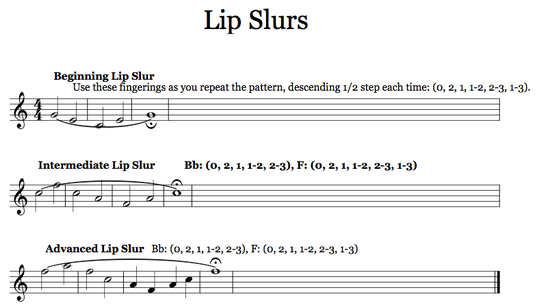|
The tongue position is an often overlooked but critical aspect of good horn playing, and goes well beyond just tonguing the notes. I encourage all horn players to incorporate lip slurs into their daily routine, as smooth lip slurs require good tongue arching. For a smooth upward slur, from a 3rd space C to a 5th line F, the tongue will arch from a "taah" position to an "ee" position in the mouth. Check out this great MRI footage of how the tongue functions in a variety of horn playing settings (rapid tonguing, double tonguing, scales, slurring, etc) that Sarah Willis of the Berlin Philharmonic has provided. Note how the tip of the tongue is employed for tonguing, but the entire tongue's position changes depending on the range played. Especially, check out how much her tongue arches for higher pitches!
0 Comments
Scales are not always a favorite practice item.... many students aren't too excited about them. Why practice boring scales?
Ask any musician: Scales are essential--they are the building blocks of music. Thorough knowledge of your scales is comparable to fluency in reading or language. They are not the ABCs, but rather a much more integrated understanding of how words work together. I suggest that ALL students spend 5 minutes per practice on scales. If you invest 5 minutes into scales every time you practice, you will be amazed at how much you can learn, and how quickly. The key is to ALWAYS practice your scales for those 5 minutes. A complete beginner can spend 5 minutes per day working on the first 5 notes of the C scale. As the student progresses, the entire scale will be achievable. At this point, the student can also use the scale to practice other aspects of playing, such as tonguing more cleanly and slurring smoothly. The student can play the C scale in slow quarter notes, then play it again with two eighth notes per note, then with slurred quarter notes. The remainder of the 5 minutes of scale work is spent on learning a new scale, such as Bb. Once the advancing beginner can play both C and Bb scales, the C scale is now quite familiar, and can be played perhaps only once at a somewhat faster (but even) tempo. The Bb scale is emphasized by a few repetitions (slurred, tongued, etc). There is now time to add arpeggios to the scales. In a few more weeks, as both scales and arpeggios are familiar, another new scale can be introduced. Every week or two the student will be able to add on either a new scale or new arpeggio, and as more scales become more familiar, they will take up less and less of the 5 minutes set aside for scale acquisition. In this building block method, a student who practices regularly will be able to play all 12 major scales, one octave, with arpeggios, often within their first year of study. Intermediate students who are able to play all 12 of their scales one octave can spend the remainder of their 5 minutes of scale study working on adding the second octaves to scales and arpeggios. They may also begin minor scale work. Advancing students who are able to play all 12 scales two octaves and with arpeggios within five minutes can also work on minor scales, including all forms. Please note that advanced students may spend significantly more time with their scales and arpeggios. They may be practicing 2 and 3-octave scales in major and all three forms of minor, and may use scales to practice a multitude of other aspects of playing, including double and single tonguing, consistency between registers, dynamics, rhythmic patterns, etc.  Lip Slurs are an essential part of practicing. They keep our lips strong and flexible. Lip slurs help our embouchure stay consistent as well (ie, we have the same embouchure for all notes), so as a student's range expands, the lip slur exercises' range can also expand. Below are three lip slurs for beginning, intermediate, or advanced students. Important Concepts: 1). Breathe in, breathe out. Imagine that your breath is always moving in one direction or the other. Never "hold" your air stationary. Correct breathing keeps your body relaxed. 2). Your ideal air stream (the air you move from your lungs into the mouthpiece when you play) is a very narrow stream of very fast air. Imagine the diameter of your air stream as the diameter of the end of your mouthpiece (it is not the diameter of the mouthpiece cup, but the back side). 3). Arch your tongue as you move up to higher notes to create the smooth lip slurs. Say "ee" in your mouth (not with your lips) as you move higher up, and "aah" as you move down to lower notes, gradually dropping your jaw and your tongue. Notes: Beginners can practice one lip slur a day, switching to a new lip slur every few weeks. More advanced players can practice at least two different lip slurs each day, with increasing complexity and range and switching more frequently between different exercises. I also encourage advanced students to make up their own lip slurs-- it can add a fun, new dimension to your lip slurs if you create your own pitch order and rhythm! The single most important key to success at horn or any musical endeavor (or life for that matter) is creating the time to let it happen. This concept sounds easy, but it is not so easy to execute. Making practice part of your daily routine requires commitment.
Daily (or nearly daily) practice is critical to becoming a great horn player. To accomplish anything, other things must be set aside. There will always be something else to do or take care of, so you have to prioritize practicing. Create-and schedule- a specific time for your practice each day. It can change from day to day, but have a set practice time. Treat your scheduled practice time as if you are meeting up with a good friend. Remember, you are investing your precious time and energy into this beautiful music because you love it. For example, a student's weekly practice schedule might look something like this: 6:00-6:30 PM Monday, Tuesday & Wednesday 5:00-5:30 PM Thursday 7:00-7:30 PM Friday (optional) 10:30-11:00 AM Saturday & Sunday Many students set timers to remind themselves to practice. Excuse yourself from other activities, including texting and phone calls, and remind everyone that now is the time you have committed to your horn playing. In my experience, the earlier in the day you practice, the better the practice quality. Most of us are more alert and have more energy, focus, and patience earlier in the day. When your body is relaxed you breathe better, which also improves your playing. Plus, you may be able to add a practice session later in the day if your first session is early enough! :-) For the true young beginner just starting to play the horn, I recommend only 5-10 minutes of practice a day for the first few months. Older beginner students will profit from 10-20 minutes of practice per day.
After a few months, beginners can gradually build up a repertoire of simple exercises, solos and etudes to practice regularly, so 10-20 minutes a day is a better goal. After the first year of playing students can practice 15-40 minutes a day, depending on their age. More advanced horn players may practice between 45 minutes and several hours a day. Longer practice times are most efficient when divided into several sessions. Expectations need to align with the experience of the player: Playing a musical instrument involves so many different parts of your brain! Practicing is not only playing and having fun: it's also hard work. Be patient and celebrate each little step. Remember that in the beginning, the brand new player is akin to an infant, learning to roll over, sit up, crawl, etc. Walking will come soon enough.... In addition, I ask students to try their best to practice every day of the week. Daily (or nearly daily) practice is essential for building beautiful tone and lasting endurance. If you plan to practice 7 days a week, when "life happens," we usually still manage to get five good days of practice per week. Of course there are weeks when that doesn't happen due to holidays, illness, scheduling conflicts, etc., but trying to practice every day often gives us the ability to average five good practice days each week. |
Erika WilsenHorn teacher and performer Categories
All
Archives
October 2022
|

 RSS Feed
RSS Feed